Carcassonne Strategy Guide, Rules and New Farmer Scoring
 Winner of the prestigious Spiel Des Jahres (German Game of the Year) in 2001, Carcassonne is quite simply the best board game you’ve never played. The unique concept behind Carcassonne has players actually constructing the board as they play, interlocking the finely-crafted selection of 72 tiles that comprise the game and scoring points based on how many cities, roads, fields and cloisters (monk houses) they develop and control. Since the game board may expand in any direction a large table is preferred, unless you can play on the floor and avoid toddlers, pets and other tile-disturbing hazards.
Winner of the prestigious Spiel Des Jahres (German Game of the Year) in 2001, Carcassonne is quite simply the best board game you’ve never played. The unique concept behind Carcassonne has players actually constructing the board as they play, interlocking the finely-crafted selection of 72 tiles that comprise the game and scoring points based on how many cities, roads, fields and cloisters (monk houses) they develop and control. Since the game board may expand in any direction a large table is preferred, unless you can play on the floor and avoid toddlers, pets and other tile-disturbing hazards.
Players begin a Carcassonne game by finding the special starting tile and placing it onto the gaming surface. The remaining tiles are shuffled and mixed face-down, finally being placed into several random stacks off to the side of the table usually beside the scoreboard. A player is chosen to go first, typically the previous game winner, and selects one of the face-down tiles from the stack. Then, based on the following rules, the player connects the drawn tile to the starting tile and the game board begins to develop into a beautiful, evolving arrangement of tiles that form an intricate landscape of controlled territory. Players continue to connect their drawn tiles to the board in sequence until all tiles are exhausted, at which point the game ends. Our Carcassonne guide is meant to be used as a helpful addendum to understanding the game, and it assumes that players have read through the original rules in full already and are familiar with the game.
Carcassonne Game Pieces
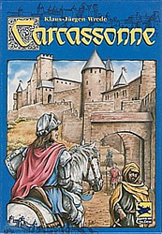 When a player connects a tile, they must always make sure that the tile portions match up on all sides with any tile(s) that they connect to. Roads must connect to Roads, Cities to Cities and Fields to Fields. If the tile does not match up on any side it cannot be legally connected. There is almost always an available place to play a drawn tile, but in the very rare instance that a tile cannot be played anywhere, it is simply placed back into the game box and out of play for the rest of the game. The player would then draw another tile and continue on as normal.
When a player connects a tile, they must always make sure that the tile portions match up on all sides with any tile(s) that they connect to. Roads must connect to Roads, Cities to Cities and Fields to Fields. If the tile does not match up on any side it cannot be legally connected. There is almost always an available place to play a drawn tile, but in the very rare instance that a tile cannot be played anywhere, it is simply placed back into the game box and out of play for the rest of the game. The player would then draw another tile and continue on as normal.
It's also important to note that passes are not allowed in the game of Carcassonne. On their turn a player must always draw and play a tile, without exception. This holds true even if the only legal play would be detrimental to the player who drew it. In most cases, however, there will be several choices on where to play a tile. Here's an in-depth look at the various ways in which the tiles interact.
After we got our copy of Carcassonne with the River we realized why some call it "Crackassonne". Hint: it's addictive!
    |
Cities: Building and completing cities is a primary focus of the game. A city can be any size, from two-tile cities up to very large constructions, but is only completed when enough tiles are added to form a walled border around the city. City portions must always be played so that they interlock with existing city portions, unless there are no other tiles surrounding it. In the example above, there is one completed city on the left (two tiles) and a larger three tile city with two unfinished top edges on the right.
    |
Roads: The landscape of a completed Carcassonne board is filled with a vast assortment of roads, which can form long highways, humorous roads-to-nowhere or delicately planned scoring barriers. Tiles containing road portions must always be played so that they interlock with exisiting roads, unless there are no other tiles surrounding it. They may not end in cities, fields or cloisters unless these tiles have existing road portions to hook into. A Road is complete only when both sides legally end into an intersection (where three or four roads meet), city-with-road tiles or cloister-with-road tiles. In the example above, there is one completed road between the two intersections (two middle tiles) and several incomplete roads.
   |
Fields: Field portions are the green areas of any tile. Fields must always connect with existing fields, and may not interlock so that a road or city tile illegally ends into them. Fields are a versatile feature of the game for the simple fact that almost every tile in play contains a field portion. Keep in mind that all of the remaining edges of the tiles must also connect legally to the board in order for the tile to be played based on the preceding rules. In this example, all of the field portions are legally connecting to other field portions. Additionally, all of the city and road features of each tile legally connect as well.
  |
Cloisters: Cloisters are single-tile homes for Monks. There are two types of Cloister tiles, those with roads and those without as shown in this graphic. Cloister tiles connect to the board in the same manner as field portions, including Cloisters with roads which of course must also follow the rules concerning road portions as above. Cloisters are the actual Monk houses found on the tile and not the tile as a whole (the field and road portions are also in play).
Meeples and Claiming Portions
![]() Once the player legally connects their tile to the board, they may claim any road, city field or cloister portion of the tile they just played by placing one of their meeples to the portion unless the portion has already been claimed (explained below). Meeples are the oddly-shaped wooden playing pieces included with the game which are surprisingly addicting to play with. In fact, most players bide their time in between turns stacking meeples into large towers, or rolling them in and out of their hands like dice. Each player gets 7 meeples for play and one meeple that acts as a placeholder on the scoreboard. There's nothing worse than having all of your meeples played to the board because you not only don't have any way to claim further portions but also you won't have any of them left to play with!
Once the player legally connects their tile to the board, they may claim any road, city field or cloister portion of the tile they just played by placing one of their meeples to the portion unless the portion has already been claimed (explained below). Meeples are the oddly-shaped wooden playing pieces included with the game which are surprisingly addicting to play with. In fact, most players bide their time in between turns stacking meeples into large towers, or rolling them in and out of their hands like dice. Each player gets 7 meeples for play and one meeple that acts as a placeholder on the scoreboard. There's nothing worse than having all of your meeples played to the board because you not only don't have any way to claim further portions but also you won't have any of them left to play with!
    |
Remember that you can't play your meeples to any of the tiles you connected to, only the tile you just played. A player claims a portion of the tile by placing one of their available meeples directly onto the desired portion. If the player has deployed all of their meeples already, they won't be able to claim further portions until they get one of their meeples back. However, they still must play a tile to the board on their turn and cannot pass under any circumstances as usual. In the example above, the blue meeple has claimed a city portion, the black meeple has claimed a road portion, the red meeple claimed a large field and the yellow meeple has claimed a cloister. There are often multiple portions on a tile that are in play, so if you want to claim the road place your meeple clearly on the road, and the same goes for claiming cities, fields and cloisters.
Getting Your Meeples Back
In Carcassonne, a player cannot reclaim a meeple that has been played to an incomplete city, road or cloister until that segment is successfully completed. This rule requires players to exercise some judment when playing their meeples to the board since they can't immediately get their meeples back. Players must examine the portion they are playing to and determine whether or not they want to risk having their meeple stranded there should it not be completed. Since a meeple is stuck on the board until its portion is complete, the fact that the player may run out of available meeples, and not be able to claim any further portions, can become a critical factor in the game.
The rules for farmer-retrieval are much more restricted than with city, road and cloister meeples. This is because farmers are never reclaimed during the game. Once farmers are played to a field they must remain there until all the tiles have been played out, at which time they will be scored. This makes the placement of farmers very critical since they are permanently stationed wherever you play them until the end of the game.
Claiming Cities and Roads
When preparing to claim a portion, you must first check to see if another player has already claimed it. This is because a player may not claim any portion that is already claimed by another player. As a helpful reference, especially when it comes to scoring them later, City meeples are called Knights and Road meeples are known as Theives. Both own the portion they reside on as well as any matching portions that are hooked directly into them.
  |
In the top example a player has just connected to a tile with a blue meeple already in the city portion. Therefore, their meeple cannot be played in the connecting city portion (position number 1) because it is building onto an already claimed city. However, the second city portion of the tile (position number 2) isn't directly hooking into an existing claimed city, so the player could choose to put a meeple in it at their option. There is also an unclaimed field section (number 3).
  |
In the bottom example, a player has just played a tile that hooks directly into a tile with a black meeple already on the Road portion. Again, the player wouldn't be able to place a meeple on their own road portion (position number 1) since it is directly hooking into a previously claimed road. However, the player could choose between an unclaimed city portion (position number 2) or one of two separate fields (positions 3 and 4) to play their meeple to.
Claiming Fields and Cloisters
 |
A meeple played to a field portion is known as a farmer. Farmers claim any connected field portions they can walk to, regardless of how far away the fields are from their home tile. Players cannot place additional farmers into a field which has already been claimed by a farmer, and this includes the player who placed the original farmer. Farmers also cannot walk across roads or through cities, which can act as barriers and separators to different farmer-controlled fields. In the graphic we see that the black meeple is controlling a large field which spans four tiles. Because of this, no other farmers can be directly played into any tile connecting to his field, including additional black meeples. However, we can see that there are also two separate fields (in positions 2 and 3) that are not controlled by the black meeple. These two fields are separate from the large field because of the road barriers, which the black meeple can't walk across.
 Meeples placed on cloisters are known as Monks. Cloisters are the actual monk houses, not just the cloister tile in general. To claim a cloister, simply place your meeple onto the large cloister house in the center of the cloister tile. You should clearly place your meeple on the house, and players usually declare "Monk" when they make the play, since there is also a field portion on the tile you could claim at your option and sometimes even a tiny road portion. It is also important to note that a player who has claimed a Cloister does not also control the field or road portions of the same tile. Any Farmers that could walk into the field portions once you connect the Cloister tile to the board would claim it just as they would any other unclaimed field segment, although they would not control the Cloister itself. Roads could also be built into the road portion, which would act as an end point for one side of the road.
Meeples placed on cloisters are known as Monks. Cloisters are the actual monk houses, not just the cloister tile in general. To claim a cloister, simply place your meeple onto the large cloister house in the center of the cloister tile. You should clearly place your meeple on the house, and players usually declare "Monk" when they make the play, since there is also a field portion on the tile you could claim at your option and sometimes even a tiny road portion. It is also important to note that a player who has claimed a Cloister does not also control the field or road portions of the same tile. Any Farmers that could walk into the field portions once you connect the Cloister tile to the board would claim it just as they would any other unclaimed field segment, although they would not control the Cloister itself. Roads could also be built into the road portion, which would act as an end point for one side of the road.
Sharing Portions and Points for a Segment
We know that you can't directly connect to an opponents portion and claim it. However, you can legally share a portion (and also share the points scored) by merging two separately claimed portions together, and in some cases even take the points away from your opponent altogether! Whenever any number of players have the exact same amount of meeples on a city, road or farm, ALL players receive the same amount of points for the segment. Points are not split between the players in the event of a meeple-tie. However, should one player be able to achieve a larger quantity of meeples on any given portion, they are said to have a majority of meeples and they alone are awarded all of the points for the applicable portion. Let's take a look at some examples.
  |
The four-way intersection tile here has 4 different available road portions on it, and the black meeple has claimed the bottom portion. The next player has hooked a curved road tile into one of the other road portions on the intersection and began their own separate new road, claiming it with a blue Meeple. While these are currently separate segments, capable of branching out into several different directions during the course of the game, they can actually be merged together strategically in order to share the points of the road if further tiles are played that allow the two roads to be connected. A player would simply need to connect the two loose ends of each road into each other.
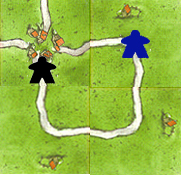 On later turns we see that two more road tiles have been added to the once separate roads, which are now one larger connected road. Since both players have the same number of Meeples, meaning no one has achieved a majority on the portion, they both score the same number of points for the completed road. This concept can be a powerful strategy element during the game, particularly when one of your opponents is busy constructing a huge road spanning numerous tiles working its way across the board. As long as you do not directly merge onto their road, should you be able to play a tile separately from the road and then connect it into the larger road you'll be able to share the large bounty of points equally with the harder working meeple. As you can imagine, the player whose portion you just merged into will often not be very pleased with your leeching maneuver.
On later turns we see that two more road tiles have been added to the once separate roads, which are now one larger connected road. Since both players have the same number of Meeples, meaning no one has achieved a majority on the portion, they both score the same number of points for the completed road. This concept can be a powerful strategy element during the game, particularly when one of your opponents is busy constructing a huge road spanning numerous tiles working its way across the board. As long as you do not directly merge onto their road, should you be able to play a tile separately from the road and then connect it into the larger road you'll be able to share the large bounty of points equally with the harder working meeple. As you can imagine, the player whose portion you just merged into will often not be very pleased with your leeching maneuver.
  |
Now we'll take a look at how to merge two separate city portions together and share the points therein, potentially an even more effective way of combating large constructions by the opponent. The player with the black meeples has claimed one city portion, and the red meeple has claimed another city portion. These two different cities are considered separate from one another since they are cut-off by walls and could actually grow out into larger cities in multiple directions without ever merging. However, should one of the players want to connect the two cities for strategical purposes they would simply need to play additional connecting city portions to bring the two separate cities together.
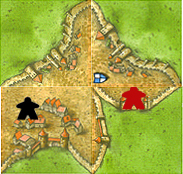 In this graphic two more tiles have been added to the once separate city portions, making them now one large city. The red and black meeples will now share any points scored when the city is completed or scored at the end of the game. This tactic can be very effective when used to lessen the scoring threat of an opponent building up a very large city.
In this graphic two more tiles have been added to the once separate city portions, making them now one large city. The red and black meeples will now share any points scored when the city is completed or scored at the end of the game. This tactic can be very effective when used to lessen the scoring threat of an opponent building up a very large city.
As stated before, the strategy for sharing portions should be used sparingly in a friendly game as it often frustrates the player who was constructing a beautiful large city or road and will typically result in retaliation by ruining each and every one of your own creations with sharing maneuvers of their own! Also, you should keep in mind that while you have effectively shared the points for a segment once you've merged into it, you cannot gain any point advantage over the opponent you're sharing with since they will still receive the same number of points anyway. It may also result in a wasted turn in which you could have been building your own structure that eventually would have resulted in many more exclusive points for your tally.
Achieving a Majority In a Portion
It is often possible to continue the merging idea in order to achieve a majority in any given portion. A majority means that you have at least one more meeple in the portion than your opponent. You can have a 2 to 1 majority, 4 to 2 majority etc. as long as you have more meeples than anyone else in that portion. This can be very important for scoring purposes, since whenever a player has a majority in a shared portion, the player with the majority is the only player that scores points for it! They get all the points when and if the section is completed, as long as they maintain their majority, and the player with the minority of meeples gets none. Zippo. Zilch.
However, when you hold a majority in a segment, even though you will have multiple meeples in the segment you only score ONCE for the segment, not for each meeple you are using to achieve the majority. So if you have a 4 to 3 majority, you still only score once for the entire construction, as if it were 1 to 0. You would not score 4x just because you have that many meeples located there. They were simply used to gain a majority and shut out the opponent from scoring any points.
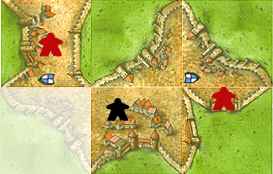 Continuing on from the example above, the player with the red meeples has now connected another city tile to the board, the long corridor type city tile, and placed another red meeple in it. Since it isn't directly connected to any already claimed portions, this play is legal. On the next opportunity, the red player can play a connecting city tile (shown here, lightly shaded) to bring all the portions together again forming one large city. The red meeples would then hold the majority in this city ,with a 2 to 1 ratio, and once it's completed would score all the points. The lone, outnumbered black meeple would score nothing unless more merging could get it back to even. As you can imagine, merging and achieving majorities may be of benefit in some situations, but the tactic must be tempered with restraint to avoid deploying too many of your precious meeples to just one single segment that will possibly share all of its points anyway. Discretion is advised as always.
Continuing on from the example above, the player with the red meeples has now connected another city tile to the board, the long corridor type city tile, and placed another red meeple in it. Since it isn't directly connected to any already claimed portions, this play is legal. On the next opportunity, the red player can play a connecting city tile (shown here, lightly shaded) to bring all the portions together again forming one large city. The red meeples would then hold the majority in this city ,with a 2 to 1 ratio, and once it's completed would score all the points. The lone, outnumbered black meeple would score nothing unless more merging could get it back to even. As you can imagine, merging and achieving majorities may be of benefit in some situations, but the tactic must be tempered with restraint to avoid deploying too many of your precious meeples to just one single segment that will possibly share all of its points anyway. Discretion is advised as always.
Scoring Cities in Carcassonne
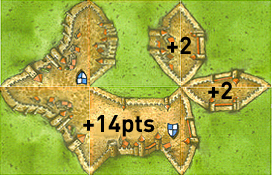 Now that we know how to connect and claim the various portions in Carcassonne, and also how the placement of meeples affects the control and scoring of each segment, it's time to learn how to score both completed and incomplete portions. We'll first focus on cities, which often hold a bounty of points for the player who completes them. A city is complete whenever enough tiles have been added to form a connected, walled border around it. Whenever a city has been completed, any meeples that had been placed within the city walls score points. Once the points have been rewarded and noted on the score board, any player(s) with meeples in the completed city return the meeples into their reserve stack ready for redeployment.
Now that we know how to connect and claim the various portions in Carcassonne, and also how the placement of meeples affects the control and scoring of each segment, it's time to learn how to score both completed and incomplete portions. We'll first focus on cities, which often hold a bounty of points for the player who completes them. A city is complete whenever enough tiles have been added to form a connected, walled border around it. Whenever a city has been completed, any meeples that had been placed within the city walls score points. Once the points have been rewarded and noted on the score board, any player(s) with meeples in the completed city return the meeples into their reserve stack ready for redeployment.
Each tile in a completed city (and not each portion) scores the player +2 points. There may also be tiny shields, also known as "pennants", found on some of the city tiles. For each shield within the completed city, the player scores an extra +2 bonus points in addition to the standard city scoring. The only exception to scoring completed cities applies to small, two-tile cities. These mini-cities only score +2 points total (not the usual four points). This rule is applied to discourage players from building lots of tiny cities as compared to several large constructions.
Incomplete cities also score points, but only at the end of the game. There are two major drawbacks to having an incomplete city with one or more of your meeples in it. The first is that you are unable to get your meeples back until the city is completed. Secondly, you will only be awarded half the number of points per tile and shield for an incomplete city. This is because at the end of the game each tile in an incomplete city scores only +1 point and any shields found within it also score just +1 point instead of the standard two points. So complete those cities!
Scoring Roads in Carcassonne
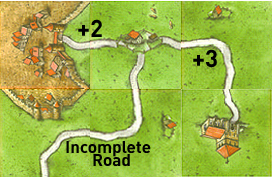 A road is complete when both ends of the road finish into an intersection, city-with-road or cloister-with-road tile. This includes looping roads to nowhere, such as those which start from an intersection and end at a different part of the same intersection. Each tile in a completed road (and not each portion) scores +1 point. Once the road is scored, players then retrieve their meeples from it.
A road is complete when both ends of the road finish into an intersection, city-with-road or cloister-with-road tile. This includes looping roads to nowhere, such as those which start from an intersection and end at a different part of the same intersection. Each tile in a completed road (and not each portion) scores +1 point. Once the road is scored, players then retrieve their meeples from it.
Incomplete roads also score points, but again only at the end of the game. Incomplete roads, though, score the exact same number of points as do completed roads. So both complete and incomplete roads score +1 points per tile. The major drawback to having meeples on incomplete roads is the fact that your meeples are stuck there until the road is completed.
Scoring Cloisters in Carcassonne
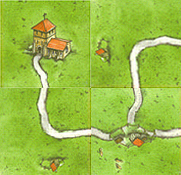 Cloisters are the monk houses found on several of the Carcassonne tiles. A cloister is complete when it is completely surrounded by other tiles, regardless of what those tiles happen to be. When a cloister has tiles surrounding it on all sides it scores +9 points, or one for each bordering tile including the cloister tile itself. It takes eight tiles total to surround a cloister and complete it.
Cloisters are the monk houses found on several of the Carcassonne tiles. A cloister is complete when it is completely surrounded by other tiles, regardless of what those tiles happen to be. When a cloister has tiles surrounding it on all sides it scores +9 points, or one for each bordering tile including the cloister tile itself. It takes eight tiles total to surround a cloister and complete it.
Incomplete cloisters also score points at the end of the game. They score the same number of points, +1 point for every tile surrounding the cloister and one point for the cloister tile itself. As usual, though, the player can't reclaim their meeple from an incomplete cloister until it is finished. In the example above, this cloister is incomplete but would currently be worth +4 points if the game were to end now, three for the tiles surrounding the cloister and one for the cloister itself.
Carcassonne Farmer Scoring
The most difficult concept to grasp for new Carcassonne players is that of farmer scoring. One of the reasons is that the original farmer scoring system, as described in most of the rule books packed with Carcassonne games, was very confusing to use! We strongly suggest that you utilize the new farmer scoring method detailed below as it seems to work the best after the many hundreds of Carcassonne games we've played.
In the new farmer scoring system, each farmer with it's own exclusive field scores +3 points for each completed city it can "supply" with goods (this just means any city they can walk to), including the smaller two-tile cities. An exclusive field is one that is not shared with an opponents meeples. Farmers do not score points for any incomplete cities they supply or cities they cannot legally walk to. In the old system, players received four points per city but they had to assess how many other farmers were supplying the same city and determine majorities regardless of exclusive fields. Believe us, going to tally all of this information in your head after a long game is not so fun! We'll look into this in the explanation below.
   |
Here we see five separate field sections. One is claimed with a green meeple on the far left tile with the black meeples having claimed two fields, one small field on the middle tile and another separate field portion on the far right tile. There are also two unclaimed field portions, one small field protected by a road in the far left tile and one very small sliver of a field at the top of the middle tile. For demonstration purposes, we'll assume that all tiles have been played at this point and it's time to score the farmers. In the new farmer scoring system, the green meeple would score +3 points for supplying the city from an exclusive field (no other farmers are sharing it). The black meeples would each score +3 points for a total of +6 points, since they both are in their own exclusive fields and supplying a completed city. No one scores for the incomplete city portion. Note that it doesn't matter that the two black meeples are supplying the same completed city as long as they are doing so from exclusive fields.
In the old farmer scoring system, whenever multiple farmers could walk to the same city and supply it, regardless of whether or not they were in their own exclusive fields, the total number of farmers supplying the city had to be determined and if a majority was established, none of the other farmers would have scored any points. It has proven to be somewhat difficult to add up what farmers can walk where and how many go with this city and that...our brains start to hurt just thinking about it! It is much simpler to spot exclusive fields and award the farmers in them +3 points no matter how many other farmers supply the same city. And it also makes for some great strategy plays late in the game that would otherwise not be as effective.
Farmer Majorities in the New System
Even though the new farmer scoring system relieves players of having to calculate majorities for each and every completed city, the standard methods of obtaining farmer majorities still exist. As stated previously, farmers control the field they start in, as well as any subsequent field portions attached to their original tile. Now matter how far the distance may be, a farmer is allowed to walk through any connected field portions and claim those fields as their own. Remember, though, that farmers are not allowed to cross roads or walk through cities. These are barriers to farmers and are used to separate fields.
Players wanting to place a farmer into a field portion of their tile must first check to see if the field has already been claimed. This may require quite a bit more looking around the board than with cities or roads, because farmers can be far, far away and still be able to walk to and control the attached field portion. Whenever someone is planning to play a farmer, anyone else with farmers should scan the board hard, checking to see if there is any legal way their own farmer(s) can walk over to the field portion in question making it off-limits to play a new farmer.
Of course, fields are subject to merging in the same way cities and roads are. So while a player wanting to "share" (hone in on) another players large field can't place a farmer on a directly-connected field portion, they could always hook it onto a tile that is not connected and then play further tiles to connect them. This is also true of creating majorities. Whenever players have the same number of farmers in a field through merging, the players each receive the same number of points for the field as all the others. And when a majority is established in the same shared field, where one player has at least one more meeple in the field than does any other player, the majority holder receives ALL of the points and the minority holders get no points.
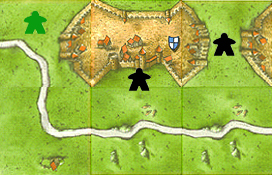 |
In this example, we can see that our previous Farmer graphics have been expanded with three new tiles connecting to them. Now all three farmers and their previously exclusive fields have been merged into one large shared field once the connecting road tiles and their field portions were added. Since it has subsequently become one large field, the black meeples now have a majority of farmers in the field (2 to 1) and can claim ALL of the points for supplying the city. However, remember that they only score the city once based on the sharing and majority rules we've previously discussed. Farmer Majorities are an integral part of an effective Carcassonne strategy as we'll soon see in the next section.
Carcassonne Strategy Guide
In this final section, we'll detail the basic guidelines for success at Carcassonne and also some of the finesse plays available that might not jump out at you immediately. Balancing some of these advanced ideas will be essential to holding an edge over your opponents, especially once they become proficient at the game themselves.
Build Big and Complete: In general, it's a solid strategy to build and complete as many large structures as you can. Building up your segments fast and effectively, by avoiding time wasting tile placements that don't immediately benefit or protect your segments, is essential to both putting a healthy dose of points on the board and also to reclaiming your meeples in a timely manner. Of course, too much of a good thing may turn out to be detrimental to your success. Be careful not to get too ambitious when it comes to gargantuan constructions since you will eventually have to complete these monsters to gain the lions share of the points. If someone comes along and plays a tile that will prevent you from completing your work of art, or you simply run out of time and tiles, you'll score the minimum points with the end-of-game scoring rules. Additionally, your poor meeple(s) will be stranded in the segment the entire time it's being built as well. Being reasonable and knowing when it's time to cap off the segment will help you avoid the dangers of greedily (and unwisely) going wild with your building plans.
Meeple Preservation and Economical Usage: In order to claim any new segment on a drawn tile, you will need to have meeples left in your reserves. If you don't have any meeples, you will be forced to complete any existing constructions-in-progress you have on the board in order to get some of them back. There is no worse feeling than drawing a Cloister tile only to look down and find you have no Meeples left to claim it with. In fact, with most of the tiles readily available early in the game it may prove beneficial to be prudent in playing your meeples to the board to avoid this very situation. This is especially true with Farmer placement, since we know that once a meeple is played to a field it may never be retrieved.
Playing Farmers to the Carcassonne landscape must be done with tact and long-term planning to be effective, since over-use of them may handcuff the player into becoming a simple bystander unable to counter opponent threats or claim new constructions. Holding on to meeples, while not being too conservative, keeps options available to you that you might not have if you get too aggressive with the segment claiming. Another item to think about would be excessive attempts at merging and gaining majorities. In order to gain a majority you're going to be deploying a minimum of two meeples to the targeted segment (and often more) which may prove to be very risky and time consuming if your opponent decides to fight back with counter-moves of their own. Don't get stuck fighting over split segments when you could be gaining exclusive points somewhere else with much less effort.
Counterfeit Existing Constructions: You may draw a tile that, while perfectly capable of being played to numerous other portions of the board, would be devastatingly effective as a "segment killer" for one of your opponents constructions. A common example would be to hook a tile with a road portion on it to the board so that the end of the road leads into an open square that your opponent would need to fill when completing their city. Since there are a limited number of tiles with both city and road portions on them, this may prevent the person holding the city from ever completing their metropolis. While this play is generally frowned upon by most players, it is entirely legal so long as the tile you've played connected to the board properly on all of the other sides. This tactic is best used in a competitive game where the completion of the targeted city would drastically affect the outcome of the game in their favor. Just remember that whenever your opponent notices what you have done, they just might decide to return the favor at a most inappropriate time and place.
To Merge or Not to Merge: As we previously discussed, merging is a way of legally sharing a segment with an opponent. You'll recall that one of the drawbacks of this maneuver is that you won't score any exclusive points, instead sharing them equally with your opponent once fully connected. A scenario where merging may be a good move is one in which you are competing for the lead against another opponent and you have the opportunity to force a merger with another opponent who is trailing both of you in points. Even though you'll both score the same number of points for the segment, tying the points gained with the person you merged with, you'll actually gain against your primary opponent and possible push your total ahead of them in the overall scheme of the game. About field merging...
Maintaining Field Control: Placing Farmers effectively is a critical component of your success in Carcassonne, especially since they are immobilized upon placement. However, following closely in importance is field preservation. Once you've played a Farmer to the board and claimed a field, you will certainly be looking to develop your field into an even more fruitful land mass by accumulating more completed cities that will also fall under your immediate control. A very potent way to do so is to build lots of two-tile cities in your existing fields, understanding that while they may not score many points directly at +2pts each at the end of the game they will prove their worth later on by providing a new crop of points for the lucky farmer that supplies them at +3pts each. However, while you're busy building your field around your excellently placed Farmer, your opponents will be looking for ways to not only merge into your field but also to work a majority against you to steal all of your hard-earned points. It is absolutely necessary to constantly monitor every aspect of your field.
Firstly, whenever a player plays a Farmer to the board you must scan your territory to make sure that there is no possible way you can walk to the field portion in question at the moment. If your Farmer can legally walk to the field where this new Farmer is trying to be played, no matter how far away it must go, you can inform the player that they are not allowed to place their Farmer in your extended field. You must be eagle eyed and aware of your reach whenever someone tries (intended or not) to illegally step on your land. Secondly, you should keep watch for players legally playing Farmers into field portions in close relation to your own fields as they will often be planning on connecting additional tiles to merge into your field. Sometimes, they will even take this strategy a step further and coordinate multiple farmer fields into a majority-gaining connection sequence. Taking over someone else's field can turn out to be a game-saving technique if used correctly. For the owner of the targeted field, it may be wise to build and then merge a separate, smaller field of your own into your premium field. This effectively gives you some back-up against someone planning on moving in on you as they now will have to play at least two of their meeples to share in the points and a whopping three if they want to take the majority share. For the hopeful merger, it is a good idea to fully calculate your chances of achieving a majority before you embark on a merging expedition. You must be careful not to waste your precious time and meeples in what can turn out to be a very costly mistep if your strategy is somehow countered.
Finishing an Opponents Construction: A play that often goes unnoticed is finishing an opponents Road or City as a defensive measure. Why would someone even think of helping out their opponent in this way? In some cases, capping your opponents outstretched road which already winds several tiles deep across the board or finishing out the last piece of a dangerous looking city may in fact end up saving you points further down the road. Late in a Carcassonne game, as the number of available tiles begins to shrink, players may find themselves unable to draw a key tile that would allow them block these developments from expanding further. Ending this threat early can avoid running into an unstoppable force further down the line. Psychologically, ending their action on a segment they've been particularly active in may also put an opponent out of their rhythm and into an unfavorable position. Of course, if you don't mind a bit of open collusion, completing someone else's project can just be a subtle way of helping out someone in need and more importantly, perhaps buying yourself a returned favor sometime in the near future.
Carcassonne River Tiles and Expansions
 The most recent versions of Carcassonne also include the River Expansion Pack, which consists of 12 additional tiles which must be played out before the standard Carcassonne tiles are played. This expansion immediately adds extra depth to the game, allowing players to have a chance at additional portions and the strategic effect of the field-dividing River. While we strongly recommend you play with the basic set until you learn the game, don't hesitate to introduce the River tiles into play. Once you do, you'll probably never play the basic game again!
The most recent versions of Carcassonne also include the River Expansion Pack, which consists of 12 additional tiles which must be played out before the standard Carcassonne tiles are played. This expansion immediately adds extra depth to the game, allowing players to have a chance at additional portions and the strategic effect of the field-dividing River. While we strongly recommend you play with the basic set until you learn the game, don't hesitate to introduce the River tiles into play. Once you do, you'll probably never play the basic game again!
ChessandPoker.com Browsing Options
Thank you for reading this featured game article! Please select one of the links below to continue navigating the Chess and Poker Dot Com website. Let us know if we can be of any further help. Good luck and happy gaming!
Game Strategy Guides More strategy guides and game solutions are waiting for you on our homepage!
Discuss this article Visit the game forums and chat with our knowledgeable community members.
Shop for games Browse our store and find some great savings on pretty cool merchandise.
Read our Blog for site updates and commentary on a variety of interesting subjects.
Contact us to make a suggestion, ask a question or comment on this article.
Make a Donation to the ChessandPoker.com website at your convenience.
Copyright © 2003 James Yates All Rights Reserved. Article written by James Yates, founder and owner of the ChessandPoker.com website. Please review our Terms of Use page for information concerning the use of this website.